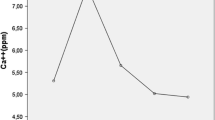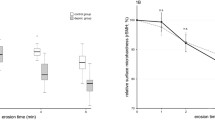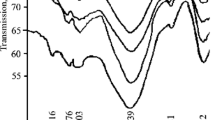Abstract
A study was conducted to determine the effect of sample preparation (grinding method) upon breadth of the diffraction profile of enamel. Collecting enamel by grinding with various cuttin tools in the low-speed dental handpiece caused broadening of all peaks (002, 211, 300 and 202) examined, compared to ball, ground, counter-part enamel. Line broadening was not observed when a single crystal of mineral hydroxyapatite was ground with a very fine diamond. In general, broadening was less pronounced with the high-speed air turbine technique. The amount of broadening caused by dental burs depended upon one or more of the following factors: coarseness of cutting instrument, grinding speed, grinding direction, and the presence or absence of water. Prolonged ball grinding of enamel also caused broadening; under identical conditions, however, annealed bone remained undamaged. These findings indicate that enamel is more sensitive to grinding damage than the mineral hydroxyapatite crystal or annealed bone. The actual cause of line broadening may be either strain due to lattice distortions or a reduction in size of individual crystallites.
Résumé
L'objet de cette étude a été de déterminer l'effet du mode de préparation (par meulage) sur la largeur des raies de diffraction de l'émail. La préparation d'émail, par meulage, en utilisant divers procédés ainsi qu'une pièce à main dentaire conventionnelle provoque un élargissement des pics obtenus (002, 211, 200 et 202) lorsqu'on la compare avec de la poudre d'émail, obtenue par meulage à l'aide de billes. L'élargissement des raies n'est pas observé lorqu'un monocristal d'hydroxylapatite est meulé à l'aide d'un diamant fin. En général, l'élargissement est moins important, lorsque le meulage est effectué à l'aide de turbines dentaires. L'importance du meulage dépend de façon variable d'un ou plusieurs des facteurs suivants: rugosité des instruments coupants, vitesse de meulage, direction de meulage, et la présence ou l'absence d'eau. Le meulage prolongé par billes de l'émail provoque aussi un élargissement dans les mêmes conditions, cependant, l'os n'est pas endommagé. Ces résultats indiquent que l'émail est plus sensible que l'hydroxylapatite et l'os. L'élargissement de raies peut être dû soit à une déformation de la maille cristalline, soit à une diminution de taille des cristaux.
Zusammenfassung
Es wurde eine Untersuchung durchgeführt, um den Einfluß der Probenvorbereitung (Zerreibungsmethode) auf die Breite des Linienprofil-Querschnittes von Zahnschmelz zu bestimmen. Gewinnung von Zahnschmelz mit den verschiedenen Schneidinstrumenten einer konventionellen Bohrmaschine verursachte eine Verbreiterung aller untersuchten Peaks (002, 211, 200 und 202) im Vergleich zum gleichen Schmelz, der mit dem Rosenbohrer zerrieben wurde. Eine Verbreiterung der Linie konnte nicht beobachtet werden, wenn ein einzelner Kristall von Hydroxyapatit mit einem ganz feinen Diamanten zerrieben wurde. Im allgemeinen war die Verbreiterung weniger ausgesprochen, wenn die hochtourige Bohrtechnik zur Anwendung kam. Das Ausmaß der Verbreiterung, das durch Zahnbohrer verursacht wurde, war abhängig von einem oder mehreren der folgenden Faktoren: Rauheit des Schneidinstrumentes, Zerreibungsgeschwindigkeit, Zerreibungsrichtung und das Vorhandensein oder Fehlen von Wasser. Verlängerte Zerreibung von Schmelz mit dem Rosenbohrer verursachte ebenfalls eine Verbreiterung. Unter identischen Bedingungen blieb der ausgeglühte Knochen jedoch unversehrt. Diese Beobachtungen zeigen, daß Schmelz für Zerreibungsschäden anfälliger ist, als Hydroxyapatitkristalle oder ausgeglühter Knochen. Die eigentliche Ursache der Linienverbreiterung kann entweder eine Schädigung infolge Distortion des Gitters oder eino Reduktion der Größe der individuellen Kristalle sein.
Similar content being viewed by others
References
Birks, L. S.: Electron probe microanalysis, p. 64. New York: Interscience Publishers 1963.
Englander, H. R., P. H. Keyes, M. Gestwichi, andH. A. Sultz: Clinical anti-caries effects of repeated topical sodium fluoride applications by mouthpiece. J. Amer. dent. Ass.75, 638–645 (1967).
Frazier, P. D., M. F. Little, andF. S. Casciani: X-ray diffraction analysis of human enamel containing different amounts of fluoride. Arch. oral. Biol.12, 35–42 (1967).
Glas, J.-E., andK.-Å. Omnell: Studies on the ultrastructure of dental enamel I. Size and shape of the apatite crystallites as deduced from X-ray diffraction data. J. Ultrastruct. Res.3, 334–344 (1960).
Guinier, A. andD. L. Dexter: X-ray studies of materials. New York: Interscience Publishers 1963.
Isaac, S., F. Brudevold, F. A. Smith, andD. E. Gardner: The relation of fluoride in the drinking water to the distribution of fluoride in enamel. J. dent. Res.37, 318–325 (1958).
Klug, H. P., andL. E. Alexander: X-ray diffraction procedures for polycrystalline and amorphous materials. New York: John Wiley & Sons, Inc. 1962.
Little, M. F., E. S. Cueto, andJ. Rowley: Chemical and physical properties of altered and sound enamel I. Ash, Ca, P, CO2, N, water, microradiolucency and density. Arch. oral. Biol.7, 173–184 (1962).
Mellberg, J. R., P. V. Laakso, andC. R. Nicholson: The acquisition and loss of fluoride by topically fluoridated human enamel. Arch. oral Biol.11, 1213–1220 (1966).
Parrish, W.: Advances in X-ray diffractometry and X-ray spectrography, Eindhoven: Centrex Publ. Co. 1962.
Author information
Authors and Affiliations
Additional information
COSTEP Summer 1966
Rights and permissions
About this article
Cite this article
Frazier, P.D., Coltvet, C.E. Adult human enamel. Calc. Tis Res. 3, 308–317 (1969). https://doi.org/10.1007/BF02058673
Received:
Revised:
Issue Date:
DOI: https://doi.org/10.1007/BF02058673




